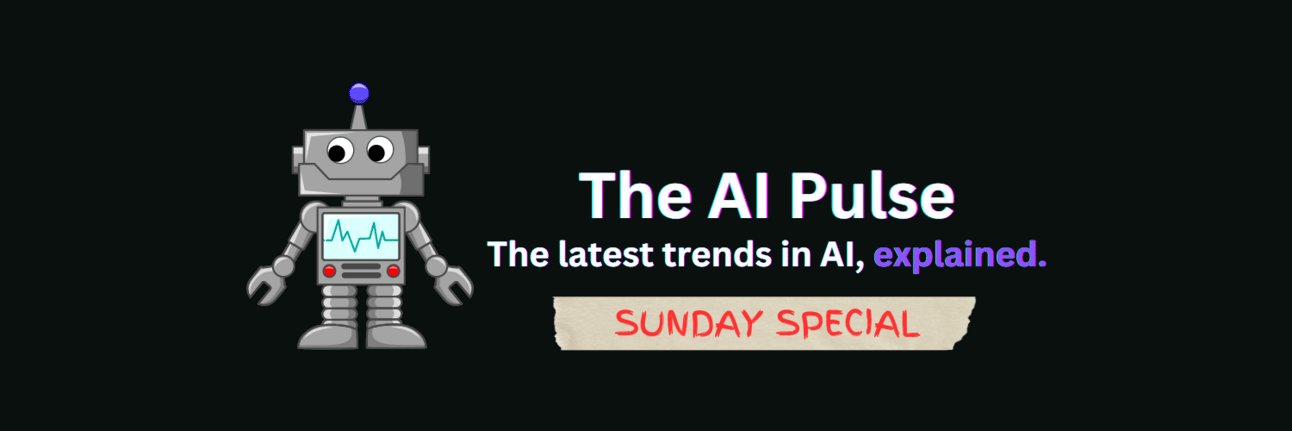
Welcome back AI prodigies!
In today’s Sunday Special:
🔊Music vs. Noise
🎻Medieval Music
🤖AI Music > Noise?
💥Reality Check
Read Time: 6 minutes
🎓Key Terms
Musical Sublimation: marking and regimenting certain “rare noises,” normalizing them into socially sanctioned forms of audible music.
🩺 PULSE CHECK
Should AI-generated music be considered music?
🔊MUSIC VS. NOISE
AI-generated art and music have received mixed receptions from creatives. Some herald generative AI tools as superpowers, while others deride them as soulless computerized creations. As generative AI redefines art as a uniquely human creation, many wonder if decoding art without grounding it in human experience is worthwhile. The cost of giving up artistry to AI is immense, as it impedes personal agency, knowledge acquisition, social understanding, and, ultimately, freedom.
In contrast to this philosophical query about AI-generated art, consider this simple question: What do you want to do today? Maybe hike, stay in bed, read, or practice the piano. What you want to do today, in this very moment, is inextricably tied to a vast, overarching narrative that has been unfolding across multiple modalities throughout your entire life. Your desires, actions, and experiences exist within an infinite set of contextual events stretching back to your birth. This system of individual and collective experiences gives you a sense of rationality and coherence when you go about your day. This intricate, socially constructed process mediates everything we do. On the other hand, many actions we take are irrational, disrupting the continuum and veering us off the path to our goals. This irrationality is an integral part of how society unfolds through time.
Now, consider another question: What distinguishes music from noise? Google will tell you that music is an orderly, rational collection of sound, whereas noise is chaotic, unpleasant, and unwanted. But what about the sound of a jackhammer—the orderly, predictable drilling sound that some construction engineers may enjoy? Almost every combination of definitions to distinguish music and sound has at least one counterexample, but one man tried to do the impossible.
🎻MEDIEVAL MUSIC
In his book Noise: The Political Economy of Music, Jacques Attali posits that music is a prophetic force that shapes and is shaped by social realities. For Attali, music’s capacity to oscillate between noise and order, between the rational and the irrational, gives music a unique power to anticipate, interpret, and transform the social order. Humans inject noise into social systems, which society rejects or turns into music. He suggests that every musical code is rooted in the ideologies and technologies of its era and simultaneously reproduces and reinforces them. Attali breaks the historical development of music from medieval times to the present day into three broad phases:
Sacrifice
Representation
Repetition
In the earliest phase, which Attali dates up until the 15th century, music was deeply embedded in communal rituals and festivities, serving as a tool for socializing and inscribing social relations. Music’s primary function was to channel a community’s inherent violence and discord into a harmonious and socially cohesive force. Turning noise into music “creates political order because it’s a minor form of sacrifice.” Attali argues that noise, which initially exists outside the social constitution, becomes legible and meaningful to the community through musical sublimation. However, once labor specialization became widespread, society removed music from the communal ritualized code and placed it within the symbolic code, which was made scarce by the professionalization of musicians. It became a commodity sold on sheet music and performed by ever-enlarging orchestras in concert halls, requiring the exchange of money. This commercialization marked the “emergence of a battle for the purchase and sale of power, a political economy,” Attali argues.
🤖AI MUSIC > NOISE?
Later, the phonograph pulled musical performance from its localized frame and distributed it to the masses. This new code of repetition persists today, scaled to an absurd degree through digital music services and playing the background role for short-form videos on TikTok, Instagram, and YouTube. No longer rooted in community or representation, music has been rendered secondary, reduced to providing an endless stream of scrollable pieces of capital content, briefly facilitating monetary exchange between producers, intermediaries, and listeners before disappearing into the digital black hole.
Attali insinuates the abstract, decontextualized nature of almost all contemporary music illustrates that we’re already in an age in which music’s political and social function has disintegrated to accommodate repetition. The rise of AI-generated music, which takes this abstraction and decontextualization to its logical extreme, represents the culmination of a multi-decade trend. From 1960 to 2010, the number of top songs glorifying casual sex, drugs, and violence skyrocketed, while songs about personal romantic connections waned slightly in popularity. While the music produced will always reflect the cultural themes of the day, today’s top tunes implicitly advocate maximizing personal gratification over the collective gratification of any social unit—the couple, friend group, or family.
Modern music’s latest invention—music-generating AI tools—effectively computes a weighted average of thousands of human-created songs. As a prompt writer, you ask it to generate a melody, verse, or even an entire song based on components of past songs. As efficient and impressive as the latest AI models are, they neuter music’s stories, emotions, and relationships, turning them into a new form of sound that is neither noise nor music. This new category of decontextualized content leaves no space for the mystery and ambiguity necessary for desire, fantasy, and human rationality to thrive during the songwriting and song-listening processes. AI-generated music super-saturates our senses with musical elements that please our subconscious but ultimately fail to provide an opportunity we take for granted—to join a stranger on an emotional journey for four minutes.
💥REALITY CHECK
To the dismay of traditionalists like Attali, younger listeners tend to evaluate music with simple questions like, “Does this sound good?” or “Do you like this song?” with little consideration about the artist’s motivations. If a song makes them feel good, the consumers of the future are happy, regardless of who the artist is. Similarly, if a meme is funny or a TikTok video is entertaining, younger viewers don’t care who made it. Why would they?
📒FINAL NOTE
If you found this useful, follow us on Twitter or provide honest feedback below. It helps us improve our content.
How was today’s newsletter?
❤️TAIP Review of the Week
“The AI Pulse always supplies valuable content.👍”
REFER & EARN
🎉Your Friends Learn, You Earn!
{{rp_personalized_text}}
Refer 9 friends to enter 🎰May’s $200 Gift Card Giveaway.
Copy and paste this link to others: {{rp_refer_url}}
